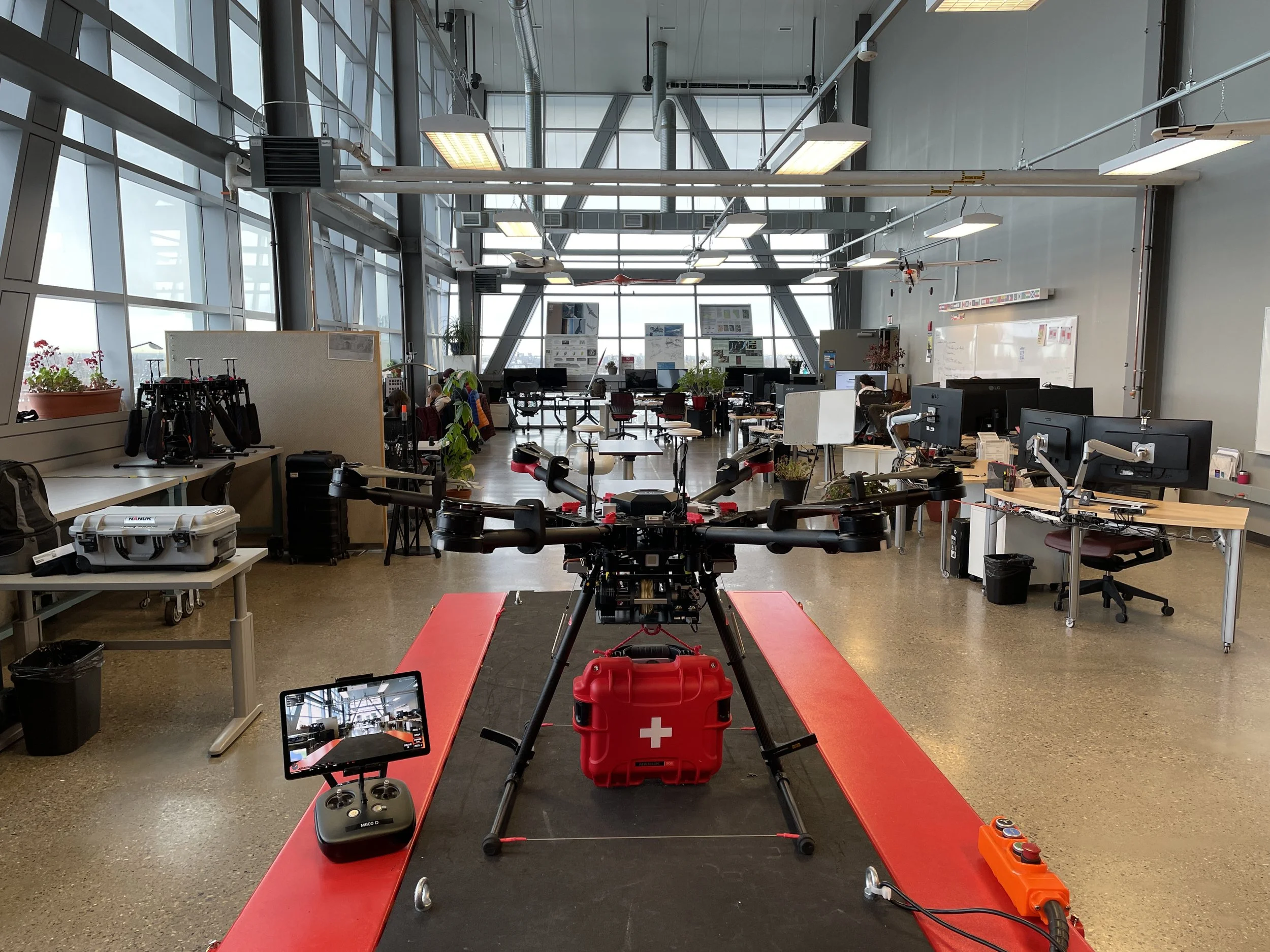Case Study: Delivery from Altitude Speeds Remote Medical Assistance for Search and Rescue Operations
Researchers at the Southern Alberta Institute of Technology Test RPAS platforms to Assist in Search and Rescue, as well as Remote-Guided Medical Triage
Customer: Southern Alberta Institute of Technology
Background
The Southern Alberta Institute of Technology (SAIT) in Calgary, Alberta, Canada is one of the foremost researchers of innovative applications for Remote Piloted Aircraft Systems (RPAS) technology. Through its Centre for Innovation and Research in Unmanned Systems (CIRUS) and Applied Research and Innovation Services (ARIS) department, Institute researchers and their students work with an array of clients exploring novel applications for drone technology. Institute research projects have ranged from applications for oil and gas exploration, environmental monitoring, search and rescue, and remote delivery of medical services. The Applied Research lab works with both public and private partners to conduct impartial testing of these cutting-edge applications, providing the necessary results and procedural knowledge to move from proof-of-concept to production.
Customer Needs
As part of a joint project with the University of Calgary and W21C, the research division for Foothills Hospital, one of Canada’s largest health facilities, SAIT researchers leveraged drone delivery to bring COVID test strips to remote indigenous communities. Extending testing capabilities into remote areas introduced added convenience to residents who would have had to travel long distances to a testing lab, and ensured residents limited their potential for further viral exposure. Ultimately, SAIT researchers demonstrated the test kits could be safely transported by RPAS, and drone delivered test kits ultimately offered a path to limiting health care inequality among these remote communities.
SAIT researchers were again called upon to explore the use of RPASs to assist in search and rescue operations. The concept for this project revolved around using drones to deliver emergency trauma kits to a simulated stranded hiker. The kit included a basic medical triage kit with gauze, clamps and tourniquets, along with a communications device. The idea was to drop the kit to a stranded hiker who would be directly connected to an emergency room doctor. The medical expert could then talk the victim through the proper use of the medical kit.
As SAIT researchers conducted initial testing, they quickly realized that landing the drone on these extended range missions was going to prove difficult. “Even in the relatively flat prairies in Alberta, field tests were losing telemetry connectivity as the RPAS descended below five meters,” said UAV/GIS Project Coordinator & Researcher, Stephanie Lapointe. “Once we realized landing and taking off would become problematic, we sought out a tethered delivery system and found the A2Z Drone Delivery winch.”
Solution
Leveraging the Rapid Delivery System enabled researchers to make accurate deliveries from altitude where telemetry data remained uninterrupted by the undulating topography. The tethered delivery technique also minimized the drone’s time-on-station, saving valuable battery life to extend the potential range of potentially-lifesaving missions.
“With the A2Z Rapid Delivery System, we were able to fly out to the simulated patient, and safely deliver the medical kit right next to them,” said Wade Hawkins, Principal Investigator. “Our stranded hiker was able to open the package, turn on the communications device, and was connected directly to our emergency doctor who tele-mentored the patient through applying several trauma treatments, including gauze packing, tourniquet and clamp. We continue to conduct deliveries to allow medical personnel to refine their communication procedures and gather patient feedback through a post-mission survey.”
According to Dr. Andrew Kirkpatrick of Alberta Health Services and the TeleMentored Ultrasound Supported Medical Interventions (TMUSMI) Research Group, “The applications for drone-borne remote medical assistance are potentially unlimited, and potentially lifesaving in emergency situations like a stranded hiker having sustained injuries. Obviously, it takes valuable time for rescuers to deploy, locate and triage a victim. With remote medical assistance, we believe we could buy those rescuers more time to reach victims and extract them to a trauma center. With our partners at SAIT, we have also been testing additional applications for the drone-based remote medical treatment.”
In expanded testing of this remote medical assistance concept, SAIT researchers delivered a portable ultrasound machine to a patient living in a remote community. The medical tele-mentor was able to successfully talk the patient through remote imaging of their own lungs and spleen. The application would bring real-time medical care to remote communities where traveling to city centers for medical care can be difficult or impossible.
Results
Leveraging the tethered delivery capabilities of the Rapid Delivery System, SAIT researchers were able to confirm a successful proof-of-concept for its remote medical assistance testing. By safely and efficiently fulfilling deliveries from altitude, the researchers also demonstrated that RPAS platforms could be used to expand the use of remote medical care beyond simple search and rescue operations to more intricate medical procedures.
As the researchers at SAIT continue to push the boundaries of RPAS applications, the research team is now conducting tests with the second generation RDS2. With its expanded payload capacity and flexible payload options, the researchers are able to transport larger and heavier payloads, opening up numerous new use cases for their partners.
“Many of the capabilities of the latest generation Rapid Delivery System are allowing us to explore new use cases,” said Adam Batchelor of the Centre for Innovation and Research in Unmanned Systems at SAIT. “If we end up in a scenario where the tether gets hung up in the trees, we can abandon the tether and still fly the drone back home. So, a lot of good scenarios have been opened up by the second-generation winch.”


